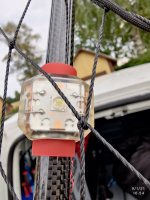Hello All.
recently purchased this product. An anti collision strobe featuring 4 x XHP70 in series (specs state 8000lm 80w and 6500k).
...Pretty underwhelmed with its performance though.
Its nicely packaged for my application, chunk of billet aluminium for the body and whole thing potted in epoxy but I really want more Jam out of it.
power wise I have a 70w coil which charges a 7ah lead acid battery so I should have lots of power to spare considering this thing has such a low duty cycle (flash,flash,pause.) think aircraft strobe flash pattern. I have opened up the electronics box attached, not sure what to comment about it, the size of a buck/boost converter going to some capacitors.
I am not worried about lifespan (well, 100hr would be nice) or cost or heat- everything below fire is acceptable
My question is: what can I do on the input side of things to really supercharge this light?
crank the voltage going to it?
some big capacitors?
Thanks!
recently purchased this product. An anti collision strobe featuring 4 x XHP70 in series (specs state 8000lm 80w and 6500k).
...Pretty underwhelmed with its performance though.
Its nicely packaged for my application, chunk of billet aluminium for the body and whole thing potted in epoxy but I really want more Jam out of it.
power wise I have a 70w coil which charges a 7ah lead acid battery so I should have lots of power to spare considering this thing has such a low duty cycle (flash,flash,pause.) think aircraft strobe flash pattern. I have opened up the electronics box attached, not sure what to comment about it, the size of a buck/boost converter going to some capacitors.
I am not worried about lifespan (well, 100hr would be nice) or cost or heat- everything below fire is acceptable
My question is: what can I do on the input side of things to really supercharge this light?
crank the voltage going to it?
some big capacitors?
Thanks!


